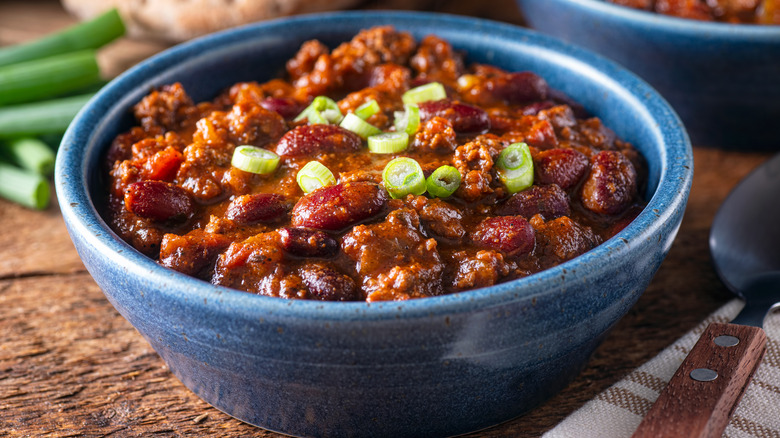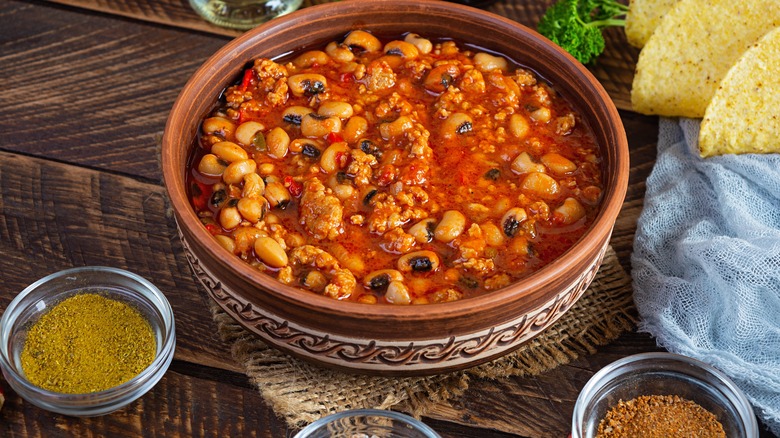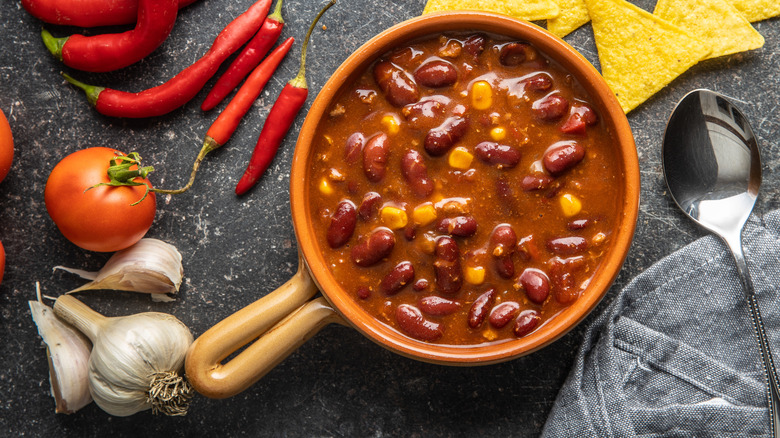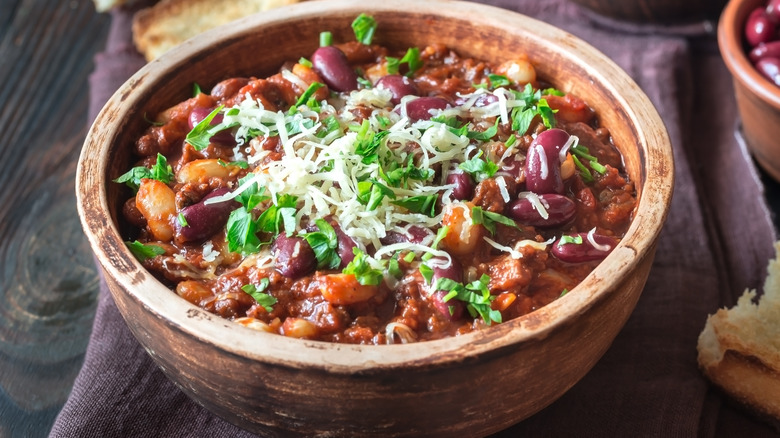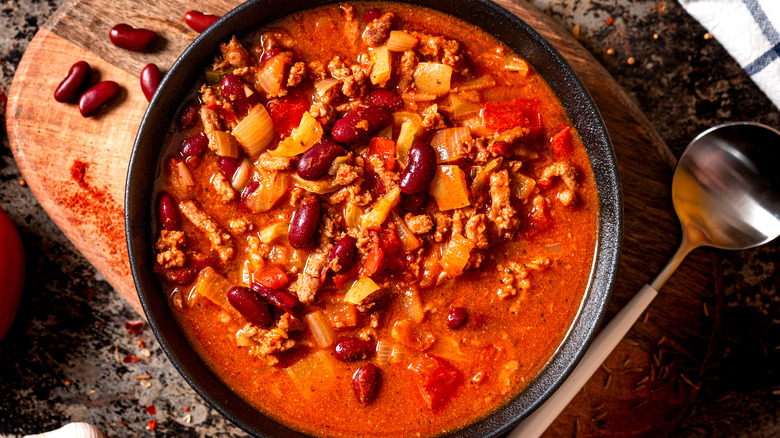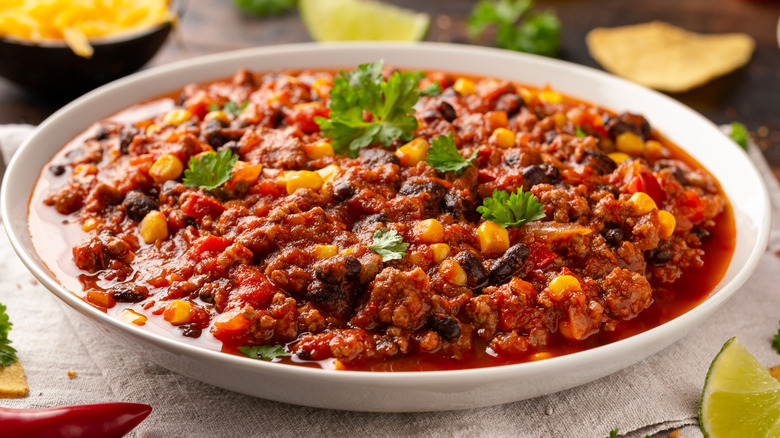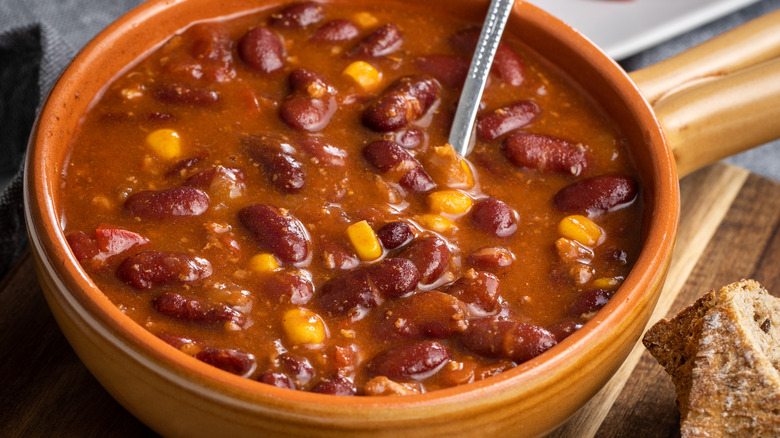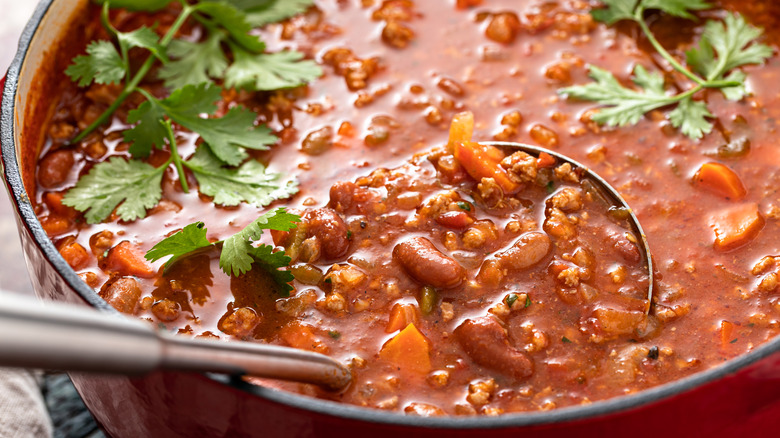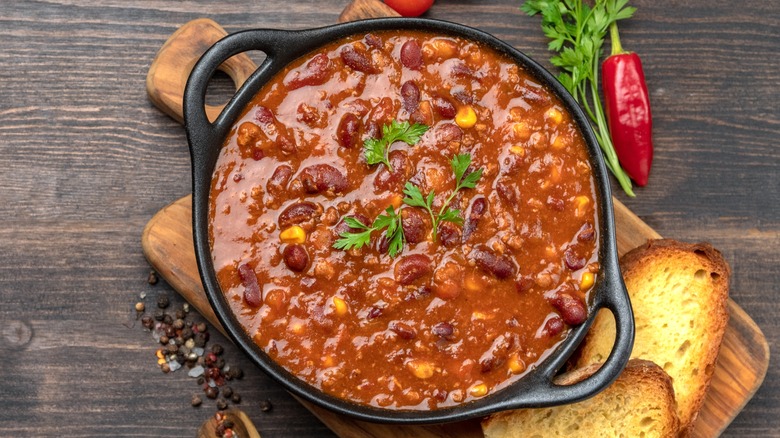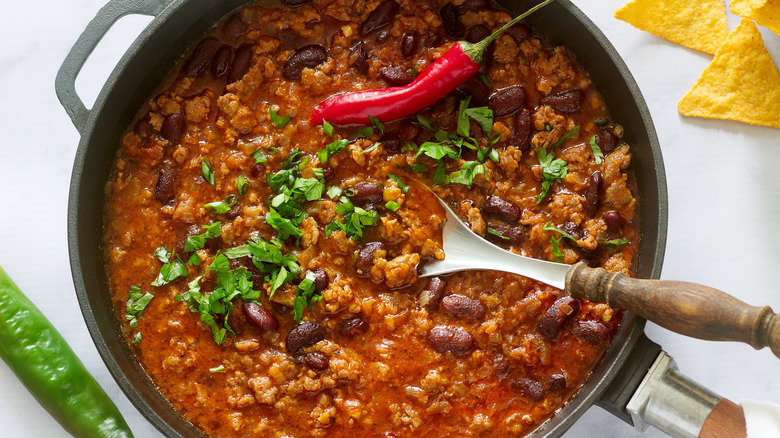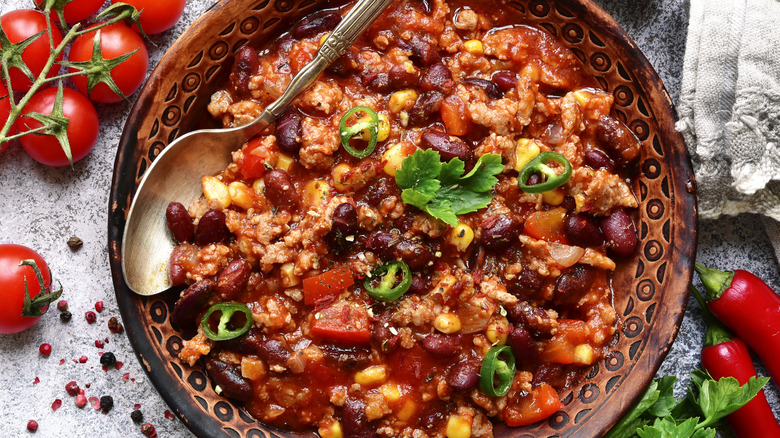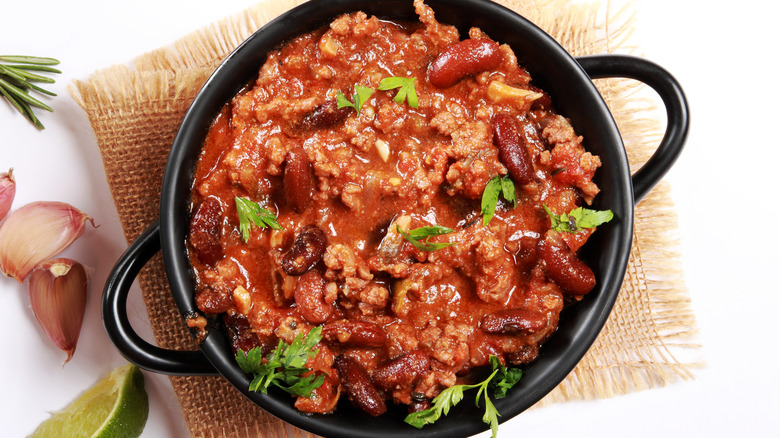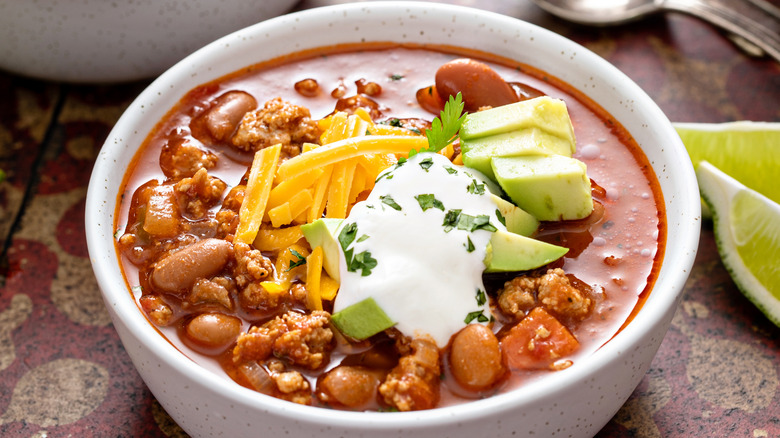Mistakes You're Making When Preparing Chili Con Carne
It may seem like a simple one-pot dish of meat and beans, but the truth of chili is a bit more involved than that (especially regarding beans, but more on that to come). We're not saying it's a complicated recipe or even takes that much effort to prepare. In fact, there's no single recipe or style of chili that's necessarily better than the rest, and some home chefs even add their own secret ingredients for a more delicious chili. Still, there are plenty of pitfalls you'll want to avoid if you're trying not to ruin your own chili con carne. At the end of the day, it's unlikely that this hearty crowd pleaser will turn out horrible after an afternoon of simmering away in a Dutch oven or crock pot, but you may not win any blue ribbons for your efforts if you haven't brushed up on some of the nuances of chili.
Whether you're competing in a chili cookoff, spooning out bowls around a campfire, or just looking for an easy weeknight dinner, the tips for whipping up the best batch of chili depend a lot more on what not to do than on fancy tricks and techniques. From choosing the wrong ingredients and prepping them poorly to misjudging cook times and forgetting to add some final flair, these are the mistakes you're probably making when preparing chili con carne if you haven't been satisfied with your outcomes thus far.
Using stale spices
You may be excited to use up some of those bottles of spices that have been clogging your cabinet for years, but experts say you probably shouldn't. Lauren Grant, food scientist and founder of Zestful Kitchen, told Mashed that packaged spices typically stay fresh for up to a year once opened, though she admits she tends to use hers a bit longer. "The key is to store them correctly — in a cool dark place away from the stove," she says, adding that this can help them last beyond the one-year mark. And it does matter. "If you use stale spices, your dish will lack that oomph, or kick of flavor, and in general will fall flat," she warns.
To add even more shelf life to your spice collection, Agua Caliente Casino Rancho Mirage Executive Chef Juan Morales told Mashed that buying whole spices is beneficial. Instead of just one year, whole spices can stay fresh up to five years, and you can simply grind them in a spice mill when you're ready to use some. According to Morales, you'll also reap the added reward of more flavorful spices when you grind on demand. If you are using a pre-ground spice, though, and can't remember how long ago you opened it, Morales says the best rule of thumb is to open the container and take a sniff. If the ground product no longer smells strongly like the spice it started as, it's time to toss it.
Using garlic and onion powders
Speaking of ground spices, garlic and onion are going to appear in just about any chili con carne recipe you find, but our experts agree that you'd be spoiling your dish if you opted for the powdered forms of either. It's not that they're pointless products, but they don't belong in your chili.
Grant says that garlic powder and onion powder are decent choices for preparing combo seasonings like dry rubs, taco seasonings, and breadings, but they're not ideal as a main ingredient. Fresh onion and garlic will deepen in flavor when cooked, permeating the dish and providing much more flavor to your finished product, she says, so this isn't a corner you want to cut unless you're looking for a bland chili con carne. Morales is particularly not a fan of onion powder, explaining that it's meant to be made from just dried onion flesh, but it can also include skins and roots without changing the labeling requirement. You never really know what you're getting with onion powder, and that can have further flavor impact on your finished chili con carne.
Overcooking the onions
It's safe to say that you generally don't want to overcook any ingredient no matter what dish you're preparing, but you really don't want to overcook the onions in a chili con carne. In fact, World Championship Chili Cook-off judge and "The Office" actor Brian Baumgartner told Mashed in 2022 that his No. 1 secret for perfecting chili is to undercook the onions until they're added to the rest of the ingredients. Here's what our experts say about that.
Morales explains that cooking onions for a long period over low heat will caramelize the sugars within, creating a super-sweet onion that's rich in flavor, and you don't want that in your chili con carne. "There is definitely a time and place for caramelized onions, but this is not one of them," Grant adds.
Instead, simply sauté your onions in butter or oil just until softened, then add to your pot when the recipe calls for them. "This softens their astringency without caramelizing them and adding sweetness to the dish," Grant explains. Don't go too far in the wrong direction and use raw onions either, though. They'll be one-dimensional and won't add the depth of flavor you're looking for from this ingredient, she cautions.
Using chili powder
This may sound like another onion and garlic situation, and you may be wondering why we didn't include this above, but there's a good reason. In fact, Morales says this warning is one of the most crucial elements you need to understand when preparing chili con carne. Chili powder and chile powder are not the same, and even though this dish is called chili, it's chile that goes into it. Confused? Let the experts help.
"Chile powder tends to be a single origin spice, meaning it's made from one type of dried chile," Grant explains. "Chili powder, on the other hand, is made with a blend of dried, ground chiles and other spices like garlic powder, onion powder, cumin, etc." She adds that a true chili con carne calls for dried chiles ground into a wet paste, but many modern recipes will allow for chile powder. Still, that's the single-origin spice made from a sole chile variety, not the hodgepodge blend found in chili powder. There's nothing wrong with a chili powder blend, and Grant says it's great for quick stews, but it will add flavors you weren't expecting in a chili con carne, and it will lack the specific spice and warmth this recipe seeks. Some of the additional spices in a chili powder blend may be great for a chili con carne, but Morales says it's better to add them separately and mindfully so you can control their effect on the finished dish.
Not browning the vegetables and meat
It's a guarantee that whatever chili con carne recipe you choose will advise you to brown your meat, and likely your vegetables, before combining your ingredients and simmering away. Yes, they'll all still cook fully if you skip this step, so there won't be any food safety concerns at your table. But our experts warn that you'll be making a huge flavor mistake if you do.
According to Grant, it's useful to keep in mind that color equates to flavor in cooking in general, so you'll want to brown your meat and vegetables for chili con carne and many other dishes, too. Morales specifies that browning your meat starts adding flavor before you even begin fully cooking it (whether roasting, stewing, or braising), and says that failing to brown meat and vegetables first will likely leave them tasting flat and boring in the end. To help you avoid this blunder, Morales advises to be sure your vegetables aren't crowding the pan while browning, or they'll begin to steam cook. Grant suggests cranking the heat up a bit higher than usual during the browning process. "Achieving color has more to do with cooking temperature than time," she says. You want to get that flavor-packed color without overcooking your meat or veggies.
Choosing the wrong beans
Chili con carne is a Tex-Mex dish that originated somewhere between southern Texas and northern Mexico, so you may have heard it referred to as Texas-style chili. Despite what you picture, Grant points out that a true Texas-style chili con carne doesn't actually contain any beans at all. "If you want it to be traditional, skip them altogether," she says. "However, if you're in the business of beans, opt for canned kidney beans," she adds. She likes them for the rich, red color that complements the deeply hued chili con carne and because they have a "firm yet creamy" texture that stands up well to the hearty meat in the recipe.
But there's a whole universe with different types of beans out there, so you may be tempted to experiment. Morales agrees that kidney beans are the top choice for chili con carne with beans, noting that their versatility takes well to most spices and flavors and praising their firm texture. But he adds that there are a few other good choices out there. "A northern white bean will add a nutty flavor, while a black bean is also a great option," he says, noting that they have similar properties to the kidney bean. For some variety, he suggests pinto beans as a good source of protein and fiber. For his own chili con carne, Morales says he prefers a three-bean medley of kidney beans, pinto beans, and black beans for a combo with great contrast.
Using water instead of stock
No one's drinking water for its incredible flavor, and our experts say this is exactly the reason you shouldn't be preparing chili con carne with water either. "Using water will just dilute all the flavor from the browning and the spices," Morales says. Grant agrees that it simply waters down your recipe while adding nothing. A stock, on the other hand, will add flavor and another level of richness, says Morales, adding that he doesn't mind if you experiment with various stocks to find a flavor you like best. Grant is less open on this one.
"Low-sodium beef broth is the way to go here. After all, it is a meat-heavy dish, and beef broth just enhances the savory flavors even more," Grant says. "You can also use chicken broth if you must."
If you're wondering why she specifies low-sodium broth, it's because recipe developers like Grant herself generally use a low-sodium broth when perfecting a recipe, so you'll want to do the same if you hope to achieve the same finished flavor. "It allows you to control the seasoning level," she says. You can add more salt to your chili con carne later if needed, but you can't remove what's already there, so don't trust the stock to choose the initial amount for you.
Not cooking it long enough
If you're in a hurry to get dinner on the table, chili con carne is not the dish for you. According to our experts, attempting to cobble together a chili quickly is a mistake you won't bounce back from, so save the recipe for another day when you have more time to prepare.
"Low and slow is always best," says Morales, referring to the low temperature and longer cooking time that a great chili demands. "This allows the flavors to combine and grow," he says. The longer cooking times will further reduce the stock, which adds richness by making its ingredients bolder and stronger, he says. This is one area where the flavor explosion will come in the end, he notes, cautioning that quick cooking will leave your flavors flat. Grant adds that this method also helps melt the fat found in the beef and tenderizes the meat. She also says that those all-important chile peppers won't develop the deep flavor a chili con carne needs if not cooked long enough, and they will taste too ripe or acidic instead. So how long is long enough? Grant advises that a really good chili con carne requires a minimum of two hours simmering over low heat, so do plan ahead.
Making a small batch
Batch size may not seem relevant to the final result of most dishes, but going small with chili con carne can be a big mistake. While you may have seen chili prepared with ground beef for convenience, Grant points out that "most chili con carne recipes use beef chuck roast, which usually weighs in around 2 ½ to 3 pounds." If you're going to make a small batch of chili, you'll need to portion your beef and freeze a partial cut of chuck for later. Grant adds that chili con carne, unlike a partial chuck, freezes incredibly well, so it's preferable to use all your meat in one shot and freeze the leftover chili instead. It also takes a long time to make a good chili, as we just learned, and Grant wonders why anyone would rather do that twice instead of freeze the leftovers of a single effort.
Morales cautions against improperly freezing your leftover chili, though. If not done right, he says, your chili will get freezer burn, and you'll lose all those flavors you carefully added, wasting the hours it took to prepare everything. If you'll be doing this often, he advises investing in a home vacuum sealer to remove all air and prevent freezer burn and other spoilage concerns.
Seasoning at the end of cooking
You may have heard that it's important for a chef to taste a dish before serving in case it needs to be adjusted, but that doesn't mean you should wait to season it until it's finished. Morales says seasoning occurs at the beginning to create your desired flavors and can continue throughout the process as they build, but it can't wait until the end. Grant agrees, saying there are scientific reasons for this.
"Adding seasonings early in the cooking process does a few things," Grant says. "For one, it allows spices to bloom, or 'unlock' their flavor. This is especially important for dried chiles and chile powder, cumin, and cinnamon. You want to get the oils in those spices warm and moving around because that's where all the flavor is!" Waiting until the end will not only deprive flavors of the chance to build, she says, but it will also result in a chalky and almost floury taste instead. There is an exception, though, and that is the popular pairing of salt and pepper, which Grant says add instant flavor and don't need time to build. Morales calls salt an activator, explaining that adding salt at the end of the process helps bring out all the flavors you've built from other spices. Salt is one of your only chances to add flavor at the end of the process, but Grant notes that a splash of something acidic like vinegar or lime can also help.
Serving it too soon
Baked goods often need to cool, and most meats require some settling time to redistribute juices after cooking, but chili con carne benefits from patience like few other recipes. The longer you can wait before serving your finished chili, the better it's going to taste. In fact, Grant advises letting it sit for a day or two before serving for best results. "Letting a hearty stew like chile con carne hang out for a bit before eating gives the flavors time to meld and essentially marinates all of the ingredients together," she explains. This method will make every bite of meat more flavorful as it absorbs the flavors of the chiles and spices longer, she says.
To further explain what's going on here, Morales adds that "spices and other flavor components mingle with each other and with the proteins and starches in the dish, producing mellower, more well-rounded flavors" as the dish sits longer. Calling back toward the tips we've already learned, like browning ingredients and spicing up the dish at the right time, Morales says the benefits of all these steps come together as chili con carne rests after cooking and the flavors you've created deepen and meld. Don't go through the effort of getting every element right just to bail on this critical step. Give it at least an hour.
Forgetting the toppings
To be fair, this final mistake isn't going to ruin your otherwise amazing chili con carne, but it would be a shame to miss out on the joys of toppings, so try not to forget them. In fact, Morales says they may be the best part! Among the more common chili toppings, some of his favorites include diced tomato, diced red onion, chopped scallions, sliced jalapeños, fresh cilantro, and shredded cheddar, but you're only limited by your imagination here. Morales loves adding crumbled queso fresco to his chili con carne, and you should feel free to experiment with toppings, too. These are flavors that only affect a bite or two without ruining an entire batch, so the stakes aren't very high if you're only adding them to the top of your individual portion.
Without toppings, chili con carne is a relatively monochrome dish of reddish brown, so this is your chance to jazz it up with some vibrant and colorful presentation. It's not all for show, though. "The onions and scallion add a great texture and crunch to the meal, and cilantro adds a cool freshness to every bite," Morales says. Shredded cheddar will add a satisfying gooeyness as it melts, but Morales encourages you to try something like a sharp Mexican Cotija for variety. Cotija cheese has a significantly salty flavor profile, so this is an especially great idea if your final taste test revealed a need for a little more salt.
